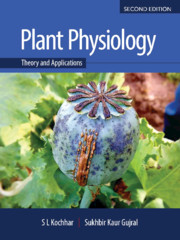Book contents
- Frontmatter
- Contents
- Foreword
- Preface to the Second Edition
- Preface to the First Edition
- Acknowledgements
- Some Common Abbreviations used in the Text
- Abbreviations for Units
- Unit I Water and Mineral Translocation in Plants
- Unit II Metabolism and Bioenergetics
- Unit III Growth and Development
- Unit IV Physiological Stress and Secondary Metabolites – Their Role in Metabolism
- Unit V Crop Physiology – An Innovative Approach
- Unit VI Breakthroughs in Plant Physiology
- Unit VII Some Experimental Exercises
- Glossary
- References
- Index
- Colour Plates
Chapter 9 - Respiration
Published online by Cambridge University Press: 12 May 2020
- Frontmatter
- Contents
- Foreword
- Preface to the Second Edition
- Preface to the First Edition
- Acknowledgements
- Some Common Abbreviations used in the Text
- Abbreviations for Units
- Unit I Water and Mineral Translocation in Plants
- Unit II Metabolism and Bioenergetics
- Unit III Growth and Development
- Unit IV Physiological Stress and Secondary Metabolites – Their Role in Metabolism
- Unit V Crop Physiology – An Innovative Approach
- Unit VI Breakthroughs in Plant Physiology
- Unit VII Some Experimental Exercises
- Glossary
- References
- Index
- Colour Plates
Summary
Respiration is a catabolic, energy-releasing process in which sugars or other organic molecules are completely oxidized to carbon dioxide (CO2) and water (H2O). The potential energy locked within the carbohydrates as well as other organic compounds is transformed into kinetic energy by this process, which is similar to combustion. Combustion is a rapid release of energy at high temperatures, the energy being converted into heat and light, whereas respiration takes place at ordinary temperatures in living cells.
Carbohydrates (glucose) are the principal substrates oxidized during respiration.
The overall reaction for complete oxidation of a glucose molecule:
Oxygen being the ultimate electron acceptor, this reaction is highly exergonic, with the release of 686 kcal/mol under standard conditions.
Fats and proteins are comparatively richer sources of energy, the former yielding on an average 9.1 kcal/g and the latter approximately 6.7 kcal/g.
Comparisons between chemical equations of photosynthesis and respiration reveal that the two processes are diametrically opposite to each other. Photosynthesis builds up carbohydrates with the absorption of CO2 and release of O2; respiration breaks up carbohydrates with the absorption of O2 and release of CO2.
The destructive process of respiration goes on at all times and in all living cells, while the constructive process of photosynthesis proceeds only in sunlight and is confined to only green cells. Photosynthesis is a more rapid process as compared to respiration.
Respiration involves glycolysis, the oxidative decarboxylation of pyruvate to acetyl CoA, the Krebs cycle (citric acid cycle) and the electron transport system, which produces a gradient that drives oxidative phosphorylation (Figure 9.1).
Glycolysis
Glycolysis (‘glyco’ meaning sugar and ‘lysis’ meaning splitting).
The glycolytic pathway is also referred to as Embden–Meyerhof–Parnas (EMP) pathway in the honour of three German biochemists who in 1940 elucidated the sequence of reactions from glucose to pyruvate. Glycolysis describes the sequential breakdown of glucose to pyruvate in a series of 10 reversible reactions, each catalyzed by a specific enzyme (Figure 9.2).
• Glycolysis takes place universally in all living organisms, from bacteria to the eukaryotic cells of plants and animals.
• Glycolysis is an anaerobic process that occurs in the cytosol.
- Type
- Chapter
- Information
- Plant PhysiologyTheory and Applications, pp. 267 - 312Publisher: Cambridge University PressPrint publication year: 2020

